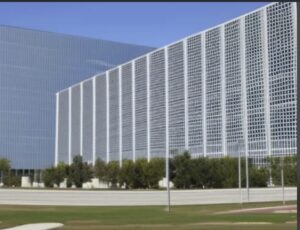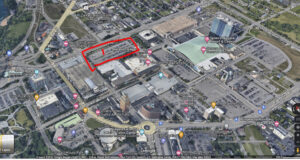February 20, 2023
From Niagara Falls Reporter, February 20, 2023:
The controversy is far from over.
It is between a mayor of a dwindling city of 43,000, down from 100,000 in 1960, a city with a famous name – once the Power City, the Honeymoon Capital of the World, now dead broke.
And a development company backed by billionaires who assembled land and, if slow to pull the trigger on development, are ready now.
Niagara Falls, New York, is the city. Niagara Falls Redevelopment LLC (NFR) is the landowner with 140 acres of land in the south end of downtown. Its billionaire owners are the Milstein brothers, Howard and Edward, of Manhattan fame, developers, bankers, and philanthropists.
The mayor is Robert M. Restaino, ending his first-year term as mayor and seeking reelection this year. Restaino, a lawyer and former city court judge, wants to build a $150 million park and event center he calls Centennial Park.
The scene of the conflict is “Parcel 0,” the centerpiece land owned by NFR.
Parcel 0 is ground zero for a war over what is highest and best for 10 acres of Niagara Falls’ property.
Both the mayor and NFR want this 10-acre parcel. For vastly different purposes.
The mayor’s plans for Parcel 0 include an events center with 6,000-7,000 seats, a parking ramp, and other “potential” amenities on the remaining few acres.
They are “potential” amenities, because the mayor does not have the funds to develop his plan in this downtrodden city.
Restaino doesn’t even have the money to buy the land from NFR and proposed borrowing federal money to make the down payment and pay it back by diverting money used to repair roads and demolish blighted houses for the next 20 years.
The mayor’s plans, driven by uncertain financing, sometimes include a splash pad convertible to an ice skating rink, an adventure course, and rope climbing walls of the parking ramp up to a rooftop beer garden.
People would climb the parking ramp walls to find a beer garden on the roof.
Though the mayor’s plans are hazy and a bit fantastic, they are couched in the language of “potential” since plans will only materialize if he gets money. He says he can’t unless he takes the land from a company that doesn’t want to sell.
NFR is not being recalcitrant simply because the mayor needs to identify funding for his potential and shifting plans. NFR wants to spend ten times what the mayor hopes to fund – to develop Parcel 0 into a 1.5 billion high-tech data center, “Niagara Digital Campus,” which will produce 550 permanent jobs and an estimated $250 million annually in economic benefits to the city.
Because NFR won’t sell the land, the mayor commenced an eminent domain proceeding to force the sale. NFR responded with a motion to annul the proceedings on several grounds, not the least of which is that a municipality should not take private land, ripe and planned for development, without something more than a dollar and a dream.
Before it got down to legal action, the parties tried to negotiate.
NFR proposed donating 11 acres of land, two blocks from Parcel 0 for the park portion of the mayor’s Centennial Park plans – and where the splash pad/ice skating rink and adventure course might go.
NFR offered 11 acres of land to the city, with the additional condition of NFR paying $250,000 per year for 10 years to the city for park maintenance.
For the events center, the city could use it own land – on Third Street and Niagara – and save $20 million in buying Parcel 0 and another $30 million building a parking ramp. There is an underutilized parking ramp next door.
Red area marked ‘1’ is property the city owns where an events center would be closer to downtown businesses.
A is the NFR proposed location of the events center and the Rainbow Parking Ramp, already existent. [see below] B is where the Data Center could go – on NFR’s Parcel 0.
The map above shows where the three locations might be.
The city rejected NFR’s land offer and made a counteroffer:
If NFR donated Parcel O, the mayor would give NFR 35 acres of city-owned land at 5000 Porter Road to potentially develop its data center.
NFR, seeking a non-litigious settlement with the city, began a site study.
5000 Porter Road, owned by the City of Niagara Falls, was previously owned by the New York Power Authority. For reasons unknown, NYPA gave the property to the city around 2015.
NFR sought environmental and title documentation for 5000 Porter Road from the city. But the city needed time to prepare or find the documents NFR wanted. NFR, eager to start building a data center, commenced its own due diligence on the land.
The attorney for NFR, John Horn, of Harter Secrest, negotiated an access agreement with the city’s outside counsel to conduct preliminary site investigation. NFR, through FOIL requests, asked for and received documents from the NYS DEC.
Before the city could execute an access agreement or provide any documents about soil and water, the DEC provided Phase I, and Phase II reports to NFR, prepared in 1986 and 1991.
The reports showed the presence of groundwater chemicals: o PCBs (not common to groundwater) o Metals — including lead, magnesium, manganese, and hex chrome o Phenols o pH issues
In surface water — in the creek and maybe some depressions: o Chlorinated solvents — methylene chloride and tetrachlorethylene o PCBs (not common in surface water) o Mercury (not common in surface water)
In sediment — in the creek and maybe some depressions o Chlorinated solvents — trichloroethylene and tetrachlorethylene o PCBs o Mercury (not common in surface water).
As a spokesman for the company said, “The last thing NFR needed was to start digging up land and housing a workforce (not to mention mission-critical computer and networking equipment) on contaminated land.”
NFR concluded that if it developed the land suggested by the mayor, an environmental disaster was a distinct possibility. At the very least, the land could take years to remediate.
Mayor Robert Restaino.
The mayor said he came up with his Centennial Park plan for Parcel 0 before NFR wanted a data center. This implied NFR’s plans were not genuine, and meant only to inflate the value of Parcel 0 by making it appear they wanted to develop on the land.
This publication investigated and obtained documents from the city that showed NFR came up with the data center first – on or before September 2021, and the mayor and his staff initially said they would assist NFR in the development.
Four months later, in January 2022, the mayor informed NFR representatives that he planned to take Parcel 0 by eminent domain unless NFR donated the land.
When the mayor said NFR came up with plans after he chose Parcel 0, it was not honest. And when the mayor said in January that the alternative land NFR offered for a park was not 100 percent NFR’s land, it simply wasn’t true. NFR’s offer is 100 percent NFR property.
And when the mayor said he offered good land on Porter Avenue that NFR could potentially develop, it was not good land, but a polluted liability of the city’s.
Meanwhile, a fight goes on between NFR and a mayor seeking funding for his Centennial Park. His outside lawyer, Daniel Spitzer, of Hodgson Russ, told the public to believe in the mayor.
The money will come, and “the first step” he said, “is land control… You have to have land control to get that pot of money,” from the state or wherever.
From several vantage points, this land control cum money comes with a growing suspicion that something is just below the surface, unseen, waiting to percolate, something altogether different than what the public has been told. As different from the mayor’s potential and varying Centennial Park plans, as was this mayor’s offer of good land laden with PCBs just below the surface.

















